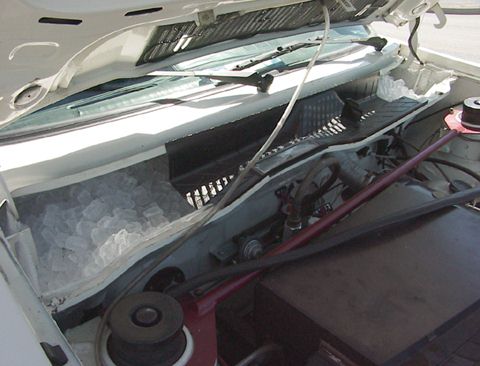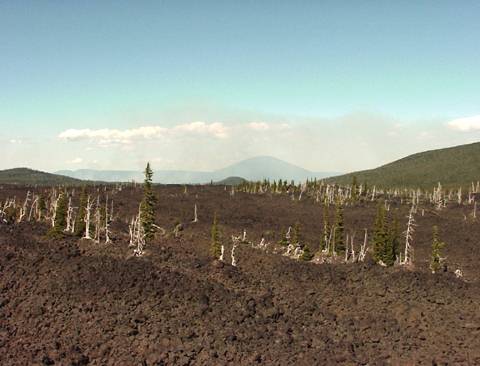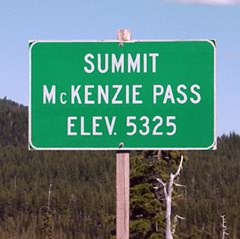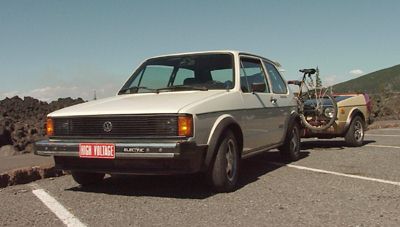Monday: Fire Watch
Monday: Fire Watch
July 29, 2002
Up at a reasonable hour, still mostly before anyone else though. Struck the tent, packed up the car, readied the trailer. Stopped into the office to check with Jennifer about road conditions. Jacques had left fairly early on Sunday, concerned that the fires to the west might close Highway 20, and force him to drive down Highway 97 to catch Highway 58 over the Willamette Pass, a very indirect route, particularly when the destination is Corvallis. The last news Jennifer had heard was that although the fires weren't threatening the road, closure was imminent, as Black Butte Ranch was likely to be evacuated, and fire crews and residents leaving the area would need unobstructed access to the highway. A check on the laptop connected to the internet confirmed the bad news, the road was now closed to all but emergency vehicles and residents leaving the area.
This new development was not particularly welcome, especially because it would add many miles to my return home, and take me over unfamiliar roads. The rumor was that Highway 242, the McKenzie Pass, was closed to all trailer traffic, and my vehicle certainly qualified on that account.
Jon had offered to be my chase vehicle, and after meeting up this morning, we made plans as best as possible for the trip back. He began packing up the last of his test, radio gear, and other belongings, and I had an early lunch at the car, parked at the Pavilion building to charge up and be close to any late breaking news about the road situation changing, perhaps Highway 20 reopening. After eating, I made a last trip into town to finish up some chores and get ready for the trip.
The first stop was to purchase some fuel. The trip to John Day had been a thirsty one for the Pusher, I had consumed nearly ten gallons of Biodiesel, and had to top up the tank with foul-smelling petroleum diesel. The gas station attendant was fascinated to be pumping fuel into a trailer, and the customer at the other side of the service island was a SolWest attendee who was filling up his motor home for the trip into the Willamette Valley. He seemed fairly unconcerned to be forced to drive the extra distance south to detour around the fire, considering it just another scenic side trip. I explained a bit about the pusher to him, we said our farewells, and set off to the next stop, a beer, wine and cigarette store to buy two bags of ice.
At the NAPA auto parts store, I dropped off the four quarts of used motor oil that came out of the Pusher to be recycled, and then ran into the motor home driver again, shopping for some oil or other product. I thanked the parts counter guys for their patience and assistance this weekend, and then showed the RV'er my ghetto air conditioning in the EV. The two bags of ice that I had bought went into the air duct under the hood, known as the "rain tray". All of the air entering the car's interior through the vents has to travel through this duct, and in order to get inside the car, the air has to now travel over and through the ice!

The rain tray is lined with "bubble plastic", some leftovers from a package that I unwrapped after receiving a shipment. The bubble plastic insulates the ice from the car body and forms kind of a dam to keep melt water from dripping into the passenger compartment vent inlet. Not shown here are two additional rigid plastic covers like the one you seen in the center of the rain tray. These help keep the ice isolated from the hood, and help direct the air around a greater area of the ice. There was room for one, and possibly two more bags of ice in the tray. I probably should have just stuffed it full, but since this was the first time I'd tried this, I opted for the two bags I already had as the initial experiment. The rain tray has a pair of drain vents at the bottom, and is designed to carry away water entering through the vent grille in the rear of the hood, so the melt water from the ice will pose no problem.
Back at the fairgrounds, I hooked up with Jon, and we prepared to leave. Our plan was to go as far as Redmond, then check the road closures and make a decision then as to what we would do.
Started the EV and Pusher, and pulled out of the Grant County Fairgrounds. sometime around noon, headed into an uncertain route west.
By all indications, the Pusher was performing just fine. I kept an eagle eye on the temp gauge and settled into driving mode. The ice in the rain tray did make the air coming through the vents cool, but it wasn't like having real air conditioning, I couldn't drive with all of the windows rolled up. Just having cold air blowing on me from the dash vents was welcome. At Dayville, I pulled over to have a look at the engine and confirm that everything was as it should be. Back on the road, we got stuck behind an old, slow motor home, without any good opportunities to pass.
At the junction of highway 19, I pulled out at a turnout to allow two logging trucks to pass, and to check the engine again. This junction is at the bottom of the east side of the Mitchell grade, my tough first test on the newly repaired engine, and I didn't want any tailgating trucks. While we were stopped, I asked Jon to follow a bit farther back, as I could actually feel the drag induced by his vehicle behind mine.
The Mitchell grade didn't prove to be much of a problem. The temperature gauge did rise, actually a bit higher than I was comfortable with, but it quickly fell when the load was eased at the summit. We descended Table Mountain, pulling into the tiny town of Mitchell to do another engine check and to use the restrooms located across from the city park. Hugh was in the cage with Henry (see my 2001 SolWest adventure for details), along with a couple of tourist's kids, feeding the now adult bear some carrots. Said "Hi" to Hugh, and went back to the car, where I managed to step in some gooey tar that had melted in the hot sun. Great way to keep my upholstery clean. Back to the road after a snack of dried fruit.
Ochoco Pass made the engine temp rise again, but no problems associated with over temperature. I've decided that I need to put the dual radiator fan setup on the trailer to help keep the coolant temperature where it's supposed to be.
Prineville, then Redmond, where we stopped for coffee and to formulate the next part of the trip. If it was going to be necessary to take highway 97, we would make that connection here. I stopped a pickup in the parking lot, and asked the driver if highway 20 had reopened. He said it hadn't. I asked about trailer traffic over highway 242, and was told that small trailers are allowed. Jon and I decided to go the 20 miles to Sisters and inquire there about traffic over the Cascades. If we needed to take 97, we wouldn't need to come back to Redmond, but could take 20 to Bend.
Things seemed normal enough in Sisters, so we pressed forward, taking the cut off just outside of town to go over the McKenzie Pass. A little ways up the road, a Forest Service vehicle was set up as a check point in the road, probably to keep too-large of vehicle from trying to use the highway ahead.
Highway 242, the McKenzie Pass, is some of the most picturesque landscape in the state. it's also one of the most treacherous roads in the state. Typically, it's closed from November until May or June due to snow. The eastern side of this highway was fairly tame, with many tight turns, but not too steep of a roadway. I was able to keep ahead of traffic with no problems, using the Pusher and electric drives to provide the power needed to reach the top.

As you climb this road, you enter into wilderness, with frequent openings of lava fields towards the top. At the summit, the trees and rocks give way to an immense expanse of lava fields. A visitor's center has been built at the top, with a large rock observatory crowned by a bronze disc engraved with pointers to landmarks both near and far. Here you see a sample of the vista. Most of the views are of more interesting things like majestic mountain peaks, but here I've focused on the reason for our detour. What you see on the horizon is smoke from the fire outside of Black Butte that closed the highway. This photo makes the lava field, trees and nearby hills look kind of tiny, but a person out in this landscape would be completely lost in the photo by the scale of the surroundings.
 Anyhow, after getting a bit of exercise climbing the several flights of stairs to the observatory and snapping some photos, we're about ready to get back to the road. The exercise was interesting because of the elevation, we're over a mile up! A new record for the EV and Pusher. The weather at the top was obviously clear and sunny, but because of the altitude and the lack of humidity, quite comfortable.
Anyhow, after getting a bit of exercise climbing the several flights of stairs to the observatory and snapping some photos, we're about ready to get back to the road. The exercise was interesting because of the elevation, we're over a mile up! A new record for the EV and Pusher. The weather at the top was obviously clear and sunny, but because of the altitude and the lack of humidity, quite comfortable.
Since the usual route from the valley to the high country was closed, there were a lot of visitors to the summit this day. It would be interesting to return sometime when the "fast" route is open and see just how much traffic this scenic route gets normally.

The EV had consumed a fair number of ampere-hours from the battery pack while climbing this mountain, but home is all downhill from here. We got underway and began the descent along the narrow, winding road that snakes off of the ancient volcanoes and into the lush McKenzie River valley. This side to the Cascades would be a real challenge to the drivetrain on any vehicle, but I'd never want to attempt climbing the road we were now coasting down. The EV's regenerative braking did a fine job of keeping the car and trailer's velocity under control, and it was seldom necessary to use the brakes to maintain a safe speed. Of course, the bonus was that I was also replacing all of those ampere-hours that the car consumed on the climb to the top. Many switchback, dogleg, and horseshoe turns in the road made it amply clear why trailers "aren't recommended" on this highway.
As we descended, the air became hotter, and the humidity rose dramatically. Our pleasantly warm high desert day was rapidly becoming a valley scorcher. After being in such low humidity for the last few days, it was a shock to remember that your body reacts to wet heat by pumping out a lot of moisture of it's own. Over in John Day, a tiny bit of perspiration goes a long way towards keeping you cool. Here on the valley side, you can sweat buckets and still not get any relief.
Eventually, highway 242 joins highway 126, just a bit south of Belknap Hot Springs. Jon has never visited there, so I made a short detour to stop for a walk around the grounds, and to get a bit of a rest from all of the steering wheel twisting we had both just done.
The next 60 miles was completely uneventful. Jon and I parted company in the parking lot of a market in Springfield just before we got on the freeway to our respective homes. Jon had another 45 minutes still to drive to get to Albany.
Arrived to find everything at home in order. Opened all of the windows to let out the day's pent-up heat and began unloading the car and trailer.
Next year, I'm going to surprise everybody. I'm going to actually drive to and from SolWest 2003 without any breakdowns. Third time's a charm...
Oh, it just goes on and on... Read why I didn't take the EV and Pusher to SolWest 2003: EV Pusher meets the Eco-Trekker
Original material ©1996-2025 Mr. Sharkey | All rights reserved
